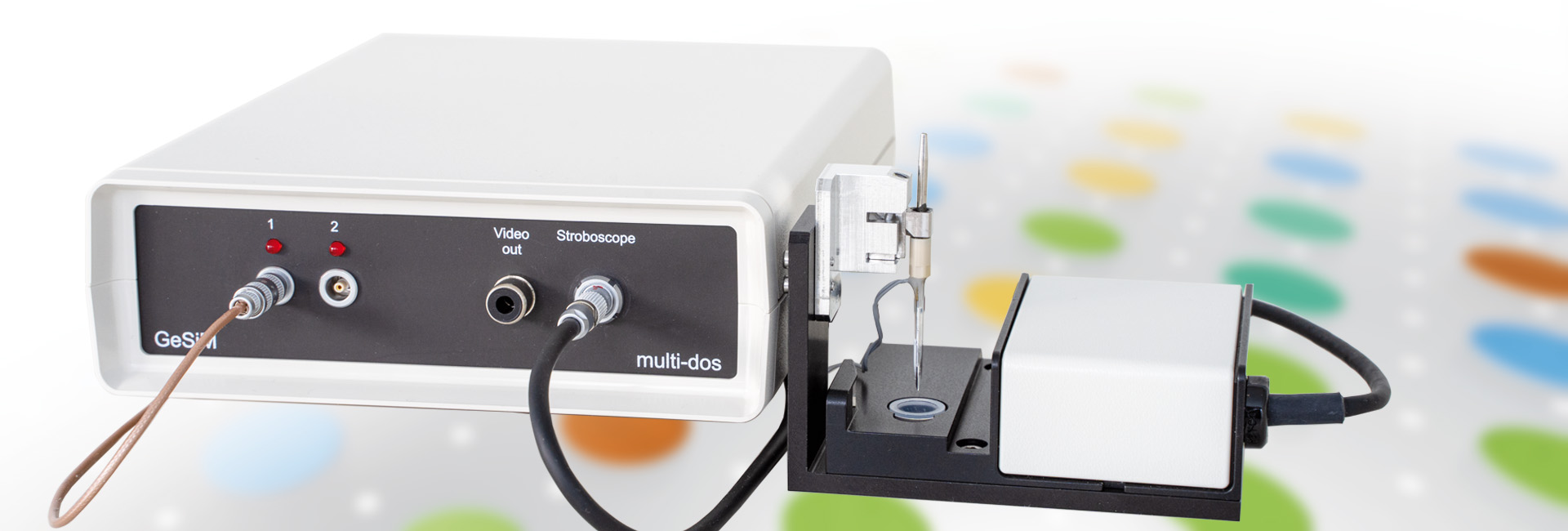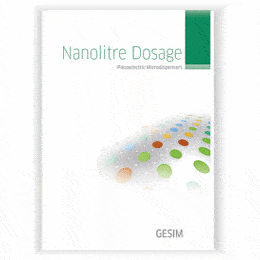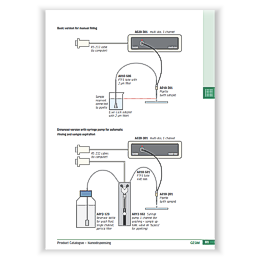Nanolitre Dosage – Piezoelectric Dispensers Easy to Integrate
How Does the Nanolitre Dispenser Work?
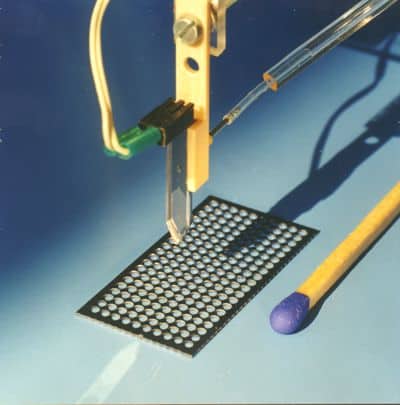
GeSiM piezo dispenser: Early version, award winner of the “Innovationspreis der deutschen Wirtschaft” 1997
GeSiM Nanolitre dispensers (also called “pipettes” or “jets”) follow the drop-on-demand principle, i.e., a drop is released exactly when the piezo ceramic actuator is triggered. This results in the bending of a silicon diaphragm behind the actuator and this in turn leads to a compression of the liquid inside the “pump chamber” and hence to the ejection of a droplet from the nozzle. After this, the ceramic returns to its initial state and the dispenser is refilled with liquid from the inlet. No valve is involved in this process.
Basically this process works for low-viscous liquids up to a viscosity of about 5 mPa*s (5 cP). Liquids with lowering viscosity at elevated temperature may be used with our heatable dispensers.
Silicon and glass wafer batch processes – well known from Microelectronics – are the technological background of our manufacturing processes. The unique design and more than 20 years experience stand for robustness, precision and versatility.
Which Dispenser Works Best for me?
Baiscally GeSiM offers piezoelectric microdispensers for two different drop volumes: The standard type SPIP emits drops between 0.6 and 1.1 Nanolitres. The other one is called PicPIP for drops of 0.1…0.2 Nanolitres. Basically the larger one has a wider viscosity range and is therefore easier to manage.
Two operation modes are available for the GeSiM dispenser: Drop bursts and continuous flow at frequencies up to 500…1000 Hz, depending on the liquid properties.
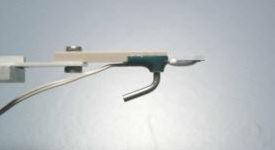
Bent steel capillary
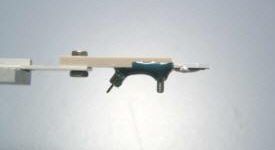
Stainless steel connector
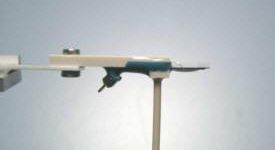
PEEK capillary
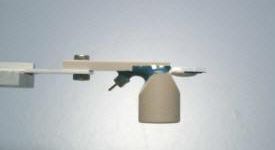
HPLC bushing 1/16 inch
Both types of dispensers are available with different housings. Please download the product brochure for more details and ordering information.
Special Dispenser Shapes
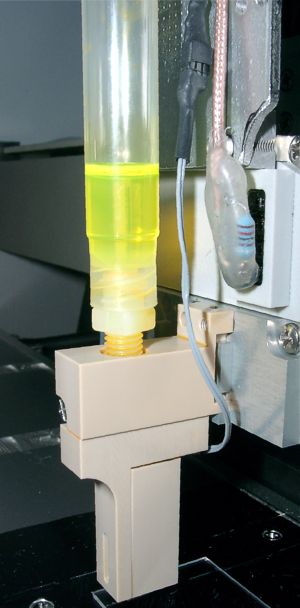
Piezoelectric (heatable) drop dispenser with cartridge reservoir
GeSiM piezoelectric dispensers are made by MEMS technologies. With this background we may support even difficult applications: Smart mixing of two liquids in the dispenser body, integrated dispensers with inlined nozzles, heatable dispensers for liquids which lower it’s viscosity at elevated temperatures.
The internal reservoir of a piezoelectric dispenser is typically in the range of few Microlitres. For dispensing larger volumes cartridges can be added (Left image).
Please enquire for further details.
multi-dos”
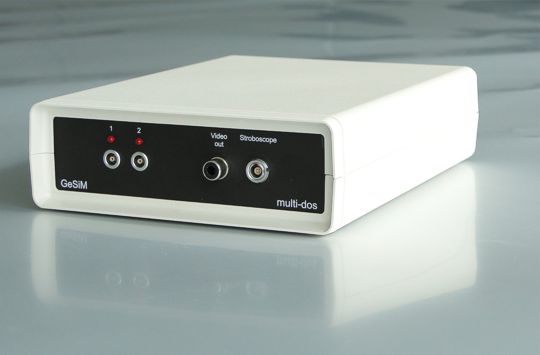
multi-dos front panel
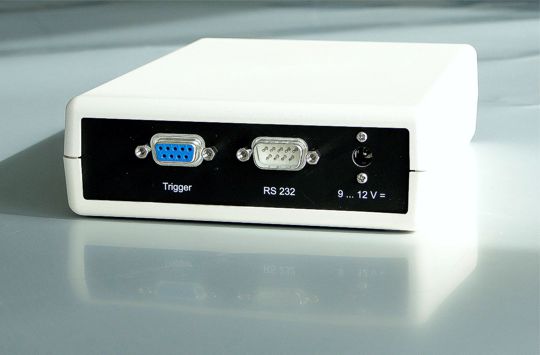
multi-dos rear side
The multi-dos is the control device for up to six independent dispensers and connects to the serial interface of your computer. The PC software mds8 supports the control of all dispensing parameters (voltage, frequency and pulse width) individually for each piezoelectric dispenser. multi-dos comes with an application programming interface and can be embedded easily into home-made software.
For real-time applications a hardware trigger synchronizes drop bursts with your own experimental setup.
Droplet Check and More
Droplet generation by piezoelectric dispensers works only at a limited viscosity range. It can be extended by heater shells enclosing the dispenser. So far this technology can be used with glues and oil.
A higher degree of automation comes with our strobe camera for droplet visualization and with syringe units for automatic rinsing of the dispenser. When a motion control system is needed please check the page Microarray Printer.
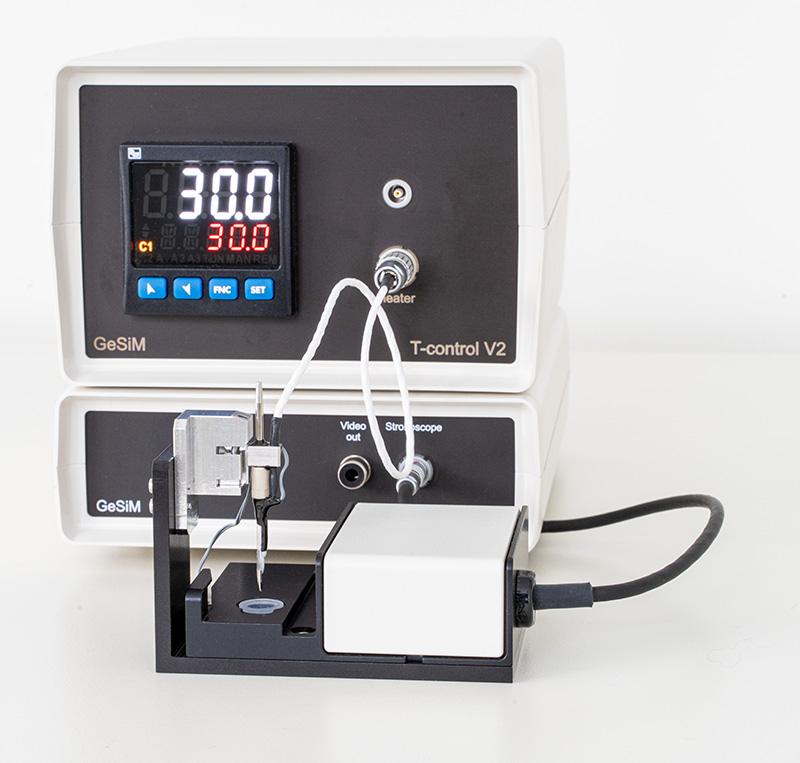
Heatable piezoelectric dispenser with temp controller
Setups with GeSiM Piezo Dispensers
Piezoelectric GeSiM dispensers work accordingly to the drop-on-demand principle. They integrate easily into your device with the following considerations:
- GeSiM piezo dispensers are valve less. Sample reservoir and dispenser nozzle should be arranged at the same level to avoid hydrostatic pressure.
- GeSiM piezo dispensers have to be primed before normal operation.
- GeSiM piezo dispensers live longer when carefully cleaned up after work.
A minimum setup comprises the piezoelectric dispenser, the multi-dos control unit and a short tube (reservoir) at the backside of the dispenser (Marked blue at the scheme below). More comfortable, add filters, syringe systems, bottles and others.
An automatic syringe system, along with a reservoir with cleaning water, enables automatic priming and rinsing of the piezoelectric dispenser (Marked red). Particularly with sticky samples thourough washing may extend life time of the piezoelectric dispense head.

Two popular setups of GeSiM micro dispensers: Budget version for manual filling/rinsing (Left, blue); Semi-automatic version with syringe support (Red)
Many liquids which fit into the viscosity range can be used with piezoelectric GeSiM dispensers. Other important parameters are density and surface tension. The latter one is important for generating smooth drops when the tiny drop passes the orifice. Please download the product brochure for a selection of dispensable liquids.
Adhesives often have high viscosities. There are two ways to dispense them: the design of the microdispenser can be optimized for higher viscosities or the viscosity is reduced by heating. GeSiM microdispensers should not be heated to more than 120 °C, i.e., the viscosity of the liquid should not exceed 5 mPa·s at 120 °C.
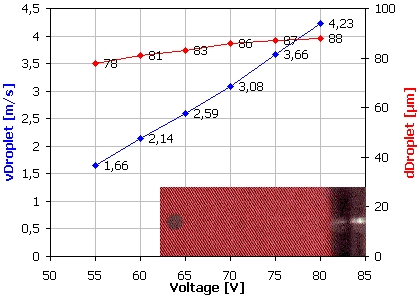
Droplet velocity (blue) and diameter (red) vs. excitation voltage at 90 °C for UVO-114
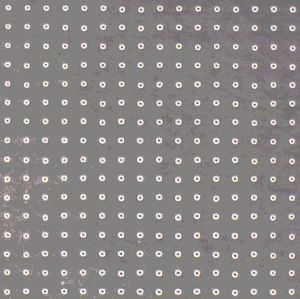
Array of UVO-114 with a spot diameter of ~ 200 µm on a glass slide
The UV-curable adhesives OG169 and UVO-114 (Epoxy Technologies) could be dispensed (viscosities at room temperature: 82 mPas and 300 – 700 mPas, resp.) The left image depicts the dependence of droplet velocity and diameter on the excitation voltage for UVO-114; the inset of Fig. 1 shows a picture of a single droplet of adhesive in front of the dispenser nozzle.
The right side picture shows an array of single epoxy spots on glass, made by the Nano-Plotter. The spot size is about 200 µm and can be varied using different piezo settings. Although the viscosity of OG169 is much lower than that of UVO-114, it needs a higher temperature for dispensing.
A number of liquids (e.g. glycerol) were successfully tested. Inthe case of two-component epoxies, the individual components must be dispensed using two different microdispensers. Mixing and curing of the epoxy then takes place on the substrate, one example being 301-2 from Epoxy Technologies.
Microdroplets ejected by the piezoelectric GeSiM dispensers fly at a speed of about 4 m/s. The high kinetic energy supports mixing of mixable liquids.
The GeSiM Droplet Collider is based on a manual swivel to host two piezoelectric microdispensers. Micrometer calipers allow to adjust position and angle of nozzles to make sure simultaneous ejected drops hit on air.
- Stroboscope camera for visual alignment and drop inspection
- Cartridge based sample delivery
- Individual settings for both dispensers
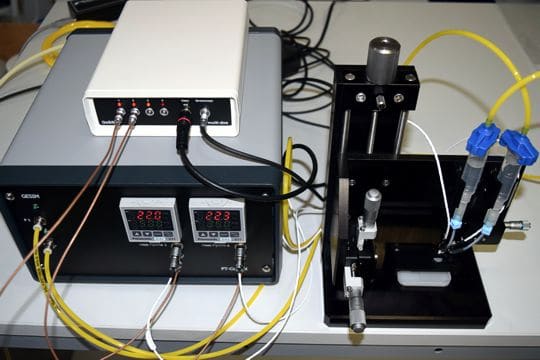
Piezoelectric Nanolitre Droplet Collider: Setup with temperature control unit and piezo driver
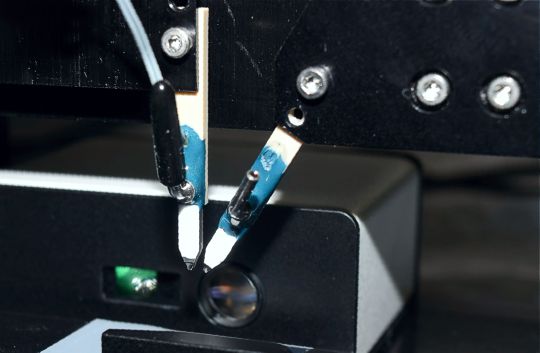
Two heatable piezoelectric dispensers in front of a stroboscope camera

